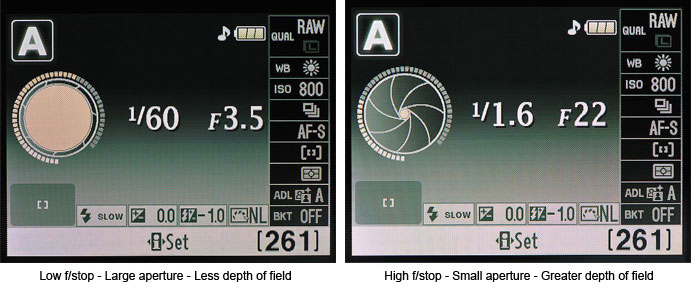What is aperture in photography?
 Aperture refers to the opening of a lens's diaphragm through which light passes. It is calibrated in f/stops and is generally written as numbers such as 1.4, 2, 2.8, 4, 5.6, 8, 11 and 16. Lower f/stops give more exposure because they represent the larger apertures, while the higher f/stops give less exposure because they represent smaller apertures. This may seem a little contradictory at first but will become clearer as you take pictures at varying f/stops. Be sure to check your manual first to learn how to set Aperture Priority for your camera, then try experimenting to get comfortable with changing the aperture and recognizing the effects different apertures will have on the end-result image.
Aperture refers to the opening of a lens's diaphragm through which light passes. It is calibrated in f/stops and is generally written as numbers such as 1.4, 2, 2.8, 4, 5.6, 8, 11 and 16. Lower f/stops give more exposure because they represent the larger apertures, while the higher f/stops give less exposure because they represent smaller apertures. This may seem a little contradictory at first but will become clearer as you take pictures at varying f/stops. Be sure to check your manual first to learn how to set Aperture Priority for your camera, then try experimenting to get comfortable with changing the aperture and recognizing the effects different apertures will have on the end-result image.How Aperture Affects Depth of Field
Depth of field is the zone of acceptable sharpness in front of and behind the subject on which the lens is focused. Simply put: how sharp or blurry is the area behind your subject.
The lower the f/stop—the larger the opening in the lens—the less depth of field—the blurrier the background.
How Aperture Affects Shutter Speed
Using a low f/stop means more light is entering the lens and therefore the shutter doesn't need to stay open as long to make a correct exposure which translates into a faster shutter speed. Again, the reverse is true: using a high f/stop means that less light is entering the lens and therefore the shutter will need to stay open a little longer which translates into a slower shutter speed.
information found at : https://www.nikonusa.com/en/learn-and-explore/a/tips-and-techniques/understanding-maximum-aperture.html (accessed 19th September 2019)
Images:
F/stop - https://www.shutterstock.com/search/appature?image_type=illustration&page=2 (accessed 19th September 2019)
Depth of field - https://www.pinterest.co.uk/pin/45669383700899302/ (accessed 19th September 2019)
Shutter speed - https://www.nikonusa.com/en/learn-and-explore/a/tips-and-techniques/understanding-maximum-aperture.html (accessed 19th September 2019)


No comments:
Post a Comment